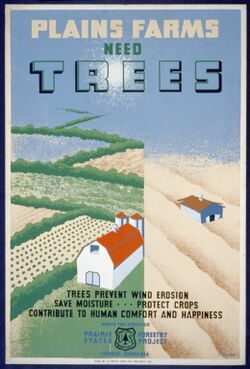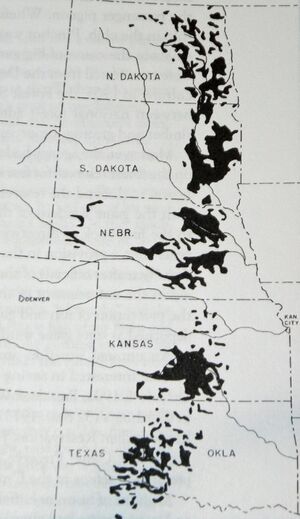الحاجز الشجري بالسهول الكبرى
| Great Plains Shelterbelt | |
|---|---|
 Plains States Forestry Project poster created by the Works Progress Administration (1940) | |
| Geography | |
| الموقع | Great Plains, United States |
| Area | 18,600 square miles |
| التأسيس | 1934 |
The Great Plains Shelterbelt was a project to create windbreaks in the Great Plains states of the United States, that began in 1934.[1] President Franklin D. Roosevelt initiated the project in response to the severe dust storms of the Dust Bowl, which resulted in significant soil erosion. The United States Forest Service believed that planting trees on the perimeters of farms would reduce wind velocity and lessen evaporation of moisture from the soil. By 1942, 220 million trees had been planted, covering 18،600 ميل مربع (48،000 km2)[2] in a 100-mile-wide zone from Canada to the Brazos River in Texas. Even اعتبارا من 2007[تحديث], "the federal response to the Dust Bowl, including the Prairie States Forestry Project which planted the Great Plains Shelterbelt and creation of the Soil Erosion Service, represents the largest and most-focused effort of the [U.S.] government to address an environmental problem".[3][4]
History
The "Number One Shelterbelt" is located in Greer County, in southwestern Oklahoma. Oklahoma's first State Forester, George R. Phillips, had the distinction of planting the very first tree in the federal program's very first shelterbelt in 1935." The first tree was an Austrian pine planted on the H.E. Curtis farm near Willow, Oklahoma, on March 18.[3]
The project called for large-scale planting of trees across the Great Plains, stretching in a 100-mile wide zone from Canada to northern Texas, to protect the land from wind erosion. Native trees, such as red cedar and green ash, were planted along fence rows separating properties, and farmers were paid to plant and cultivate them. The project was estimated to cost $75 million over 12 years. When disputes arose over funding sources (the project was considered to be a long-term strategy and therefore ineligible for emergency relief funds), FDR transferred the program to the Works Progress Administration (WPA).[5]
The Great Plains Shelterbelt was allowed under the 1924 Clarke–McNary Act and was carried out by the WPA.[2] Project headquarters were in Lincoln, Nebraska,[6] and Raphael Zon served as the technical director. The U.S. Forest Service and Civilian Conservation Corps assisted.[7] "The Shelterbelt Program of 1935–1942 ... [was] later known as the Prairie States Forestry Project."[8]
By 1942, 30,233 shelterbelts had been planted, which contained 220 million trees and covered 18،600 ميل مربع (48،000 km2).[2]
Restoration efforts in the 21st century
اعتبارا من 2010[تحديث], "Many shelterbelts in Kansas and throughout the central Great Plains are old and are no longer providing the benefits that they used to", according to Kansas State Forester Larry Biles.[9]
اعتبارا من 2004[تحديث] in Nebraska,
Today, the growth and vigor of many of the trees has declined due to close spacing, age, and invasion of undesirable, short-lived trees. The Nebraska Forest Service and the Upper Elkhorn Natural Resource District, in cooperation with the Schleusener family, has established two demonstration areas within this windbreak to show methods of improving the condition of the remaining trees and to encourage new growth and establishment of desirable trees. The area closest to the roadway will remain unaltered as a living reminder of the Prairie States Forestry Project and the efforts of Nebraskans to protect our valuable farmland.[7]
In 2010, federal grants were made available for shelterbelt maintenance and restoration in Kansas, North Dakota, South Dakota, and Nebraska as part of the Central Great Plains Shelterbelt Renovation and the Central Great Plains Forested Riparian Buffer CCPI proposals.[10][11] Funding for the CCPI (Cooperative Conservation Partnership Initiative) is provided as a project of the Department of Agriculture's Natural Resources Conservation Service.[9]
انظر أيضاً
- التحريج
- Agroforestry
- Buffer strip
- تصحر
- هندسة النظم البيئية
- Ecological engineering methods
- Ecotechnology
- Energy-efficient landscaping
- Great Plan for the Transformation of Nature
- سياج نباتي
- Human ecology
- Macro-engineering
- السور الأخضر العظيم (أفريقيا)
- سور الصين الأخضر العظيم
- غابة حماية
- Sand fence
- الزراعة المستدامة
- كاسر رياح
References
- ^ "Fighting the Drouth" Popular Mechanics, October 1934.
- ^ أ ب ت Hurt, R. Douglas. "Forestry on the Great Plains, 1902–1942". Kansas State University. Retrieved سبتمبر 21, 2009.
- ^ أ ب "The "No. 1 Shelterbelt" celebrates 75 years". Southern Group of State Foresters. Retrieved مارس 2, 2012.
- ^ Sauer, Thomas. "The Dust Bowl's Prairie States Forestry Project: Model for an Effective Global Climate Change Strategy?" in The ASA-CSSA-SSSA International Annual Meetings (November 4–8, 2007).. Retrieved on 2012-03-02.
- ^ "American Experience. Troublesome Creek". PBS. Retrieved مارس 2, 2012.
- ^ Hoagland, Bruce. "Shelterbelts". Encyclopedia of Oklahoma History and Culture. Oklahoma Historical Society. Retrieved مارس 1, 2012.
- ^ أ ب "The Prairie States Forestry Project". Nebraska History. Archived from the original on يوليو 2, 2004. Retrieved مارس 2, 2012.
{{cite web}}: CS1 maint: unfit URL (link) - ^ Lana, E.. (1980). "Growth and survival of shelterbelts"., North Dakota State University. Retrieved on 2012-03-02. "The Clarke–McNary Act of 1924 provided Federal assistance that made it possible for landowners to purchase planting stock at cost. Governmental programs were developed in the 1930s to help relieve the effects of drought in the Great Plains. The Shelterbelt Program of 1935-1942 (later known as the Prairie States Forestry Project) was one of these programs. The purpose of the Shelterbelt Program was twofold: (a) the planting of windbreaks throughout the eastern plains to reduce wind erosion and (b) to provide relief employment. The program was administered by the U.S. Forest Service until 1942, when responsibility was transferred to the Soil Conservation Service. The purpose of the study was to inventory 20 Prairie States Forestry shelterbelts in Cass, Barnes and Ransom counties of southeastern North Dakota."
- ^ أ ب "Shelterbelt Renovation". Kansas NRCS. Retrieved مارس 2, 2012.
- ^ "Funding now available to renovate shelterbelts". Dodge City Daily Globe. Dodge City, Kansas. يوليو 27, 2010. Retrieved مارس 2, 2012.
- ^ "South Dakota Ag Connection – Funds Available to Renovate Shelterbelts, Forested Riparians". Retrieved مارس 2, 2012.
Notes
- Bates, C. G. (ديسمبر 1, 1934). "The Plains Shelterbelt Project". Journal of Forestry. 32, no. 9 (14): 978–991.
Further reading
- Hurt, R. Douglas. "Forestry on the Great Plains, 1902-1942". Kansas State University. Retrieved سبتمبر 21, 2009. A fuller account of the Great Plains Shelterbelt, describing its limitations and its successes, with a history of the development of forestry in the Plains
- Illustration and description of a typical farmstead shelterbelt in South Dakota Archived أكتوبر 19, 2013 at the Wayback Machine
- Rutkow, Eric (2012). American Canopy: Trees, Forests, and the Making of a Nation. New York: Scribner. pp. 255–261. ISBN 978-1-4391-9354-9.
- Sauer, Thomas. "The Dust Bowl's Prairie States Forestry Project: Model for an Effective Global Climate Change Strategy?." in The ASA-CSSA-SSSA International Annual Meetings (November 4–8, 2007).. Retrieved on 2012-03-02.
External links
- The Prairie States Forestry Project (1940) at the Internet Archive
- Prairie States Forestry Project in Kansas - Part 1, Historical video footage from the Kansas Forest Service
- Prairie States Forestry Project in Kansas - Part 2 Historical video footage from the Kansas Forest Service
- CS1 maint: unfit URL
- Short description with empty Wikidata description
- Use mdy dates from September 2022
- مقالات فيها عبارات متقادمة منذ 2007
- جميع المقالات التي فيها عبارات متقادمة
- مقالات فيها عبارات متقادمة منذ 2010
- مقالات فيها عبارات متقادمة منذ 2004
- Works Progress Administration
- Conservation projects in the United States
- Great Plains
- Dust Bowl
- Soil fertility
- Works Progress Administration in Nebraska
- Works Progress Administration in Oklahoma
- Works Progress Administration in Kansas
- Works Progress Administration in North Dakota
- Works Progress Administration in South Dakota
- History of forestry in the United States
- Works Progress Administration in Texas
- United States Forest Service
